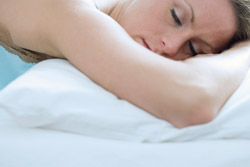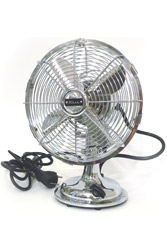- Introduction to menopausal sleep disturbances
- Physiology of sleep
- Why are sleep disturbances more common in menopause?
- Who experiences menopausal sleep disturbances?
- Impact of menopausal sleep disturbance
- How is menopausal sleep disturbance treated?
Introduction to menopausal sleep disturbances

Poor sleep quality in menopause may be real or perceived; studies have shown that women who perceive their sleep quality to be poor do not necessarily show objective differences (e.g. measured by brain activity during sleep) in the length of time for which they slept, or the depth of sleep that they achieved. Sleep patterns change with ageing, and compared to younger women, older women typically sleep for a shorter duration, do not sleep as deeply and report difficulty maintaining rather than achieving sleep.
 |
For more information on the symptoms associated with menopause and what approaches can be used to minimise their impacts, see Menopause. |
Physiology of sleep
Sleep, a state in which awareness, responsiveness, brain activity and movement decrease, can be categorised as either rapid eye movement (REM) or slow wave (non-REM) sleep. In REM sleep the brain remains very active, rapid eye movements occur, dreams are common and arousal occurs relatively easily. Slow wave or non-REM sleep is deep sleep in which brain activity decreases markedly and arousal is more difficult. Metabolic rate decreases and energy is conserved during sleep, allowing body functions such as synthesis of proteins and complex molecules occur more rapidly than when a person is awake. Other functions of sleep are unclear; however, the fact that humans and other mammals have maintained long periods of sleep while evolving, despite the vulnerability that sleep and associated lack of awareness brings, suggests it is extremely important.
Individuals typically experience phases of REM (light) and non-REM (deep) sleep throughout the night, with REM sleep phases occurring approximately every 90 minutes. The need to sleep is associated with the duration of time since the last period of non-REM sleep, and increasing sleep deprivation is associated with increased non-REM and reduced REM sleep. In adults, sleep normally occurs once a day. However, children typically experience polyphasic sleep (sleeping at multiple times in the day) and elderly individuals often revert back to this pattern of sleep. The ability to sleep is influenced by many stimuli, including pain, temperature, light, noise and hunger.
 |
For more information about the stages of sleep and how sleep can become disordered, see Sleep. |
Why are sleep disturbances more common in menopause?

Evidence suggests that sleep disturbances increase in the menopausal period. For example, one study of 213 women reported that amongst women not using hormone replacement therapy (HRT), there was a significant increase in sleep disturbance over a 3-year period of menopausal transition. Other studies also report more sleep disturbance in the period of menopausal transition when menstrual cycles become irregular (peri-menopause) and following the final menstrual period (post-menopause), compared to pre-menopause. However, many studies showing associations between menopause and sleep rely on self-perceived quality of sleep. Studies which have used physiological measures (e.g. brain activity during sleep) to assess sleep quality have shown that perceived sleep quality does not always correlate with an objective measure of sleep quality. Women may perceive that their sleep quality decreases despite no changes in the depth and duration of sleep.
The exact reasons why sleep disturbances are more prevalent in menopausal women are not well understood. Research has not yet determined how, or if, sleep disturbances are associated with the hormonal changes of menopause. While hormonal changes are thought to play a role, they are probably only one of many factors contributing to the age-related increase in sleep disturbances that occurs in both women and men. Many other non-hormonal aspects of menopause also appear to play a role, as do comorbid primary symptoms of menopause, particularly vasomotor symptoms.
Hormonal changes
Progesterone and oestrogen, levels of which decrease with menopause, both impact on sleep. Progesterone has a sedative effect due to its stimulation of benzodiazepine receptors (receptors for benzodiazepines, which have either anti-anxiety or sedative effects). It also stimulates respiration, which may reduce the likelihood of sleep apnoea (breathing cessation during sleep). The effects of oestrogen are more complex, but it has been shown to increase the number of REM sleep cycles. Increased frequency of awakening from sleep is associated with low oestrogen levels. Oestrogen also affects thermoregulation (regulation of body temperature) and, by decreasing core body temperature, improves menopausal vasomotor symptoms, which are a primary determinant of sleep quality in menopausal women.
Hormone replacement therapy (HRT) has been shown to improve menopausal sleep disturbances. In one study, women using HRT did not experience an increase in sleep disturbances in the menopausal transition, while those not using HRT reported more disturbed sleep. However, it is not clear whether the relationship between HRT and sleep is direct, or whether HRT improves sleep indirectly by reducing vasomotor menopausal symptoms.
In addition, several studies have implicated luteinising hormone (LH) in sleep disturbance. Luteinising hormone is produced by the pituitary gland and is the hormone that triggers ovulation in women. In menopause, when the ovaries fail to respond (ovulate) to an increase in LH secretion from the pituitary gland, it in turn responds by producing additional LH. Thus LH levels rise in menopause. One study reported that surges in LH concentrations occurred immediately before waking episodes in menopausal women and that these surges were associated with increased body temperature and sleep disturbance. This study suggested that LH changes play a role in menopausal insomnia and that treatments aiming to reduce LH surges may be effective in improving sleep for these women.
Sleep-related breathing disorders are more common in men than women, but increase during menopause and are thought to underpin menopausal sleep disturbances. High progesterone levels during reproductive life are thought to protect women from breathing disorders, leading to an increased prevalence post-menopause. However, the increase may also be explained by ageing, as the prevalence of sleep-related breathing disorders also increases with age.
Vasomotor symptoms

Ageing
With ageing, the prevalence of diseases that might potentially adversely impact sleep increases. These include:
- Arthritis;
- Type 2 diabetes;
- Fibromyalgia; and
- Sleep-related breathing difficulties.
Also, the prevalence of snoring and awakening in women’s partners increases as they age and may create further sleep disturbances.
Sleep-related disordered breathing
Sleep-related breathing disorders increase in prevalence with age for both men and women, although it remains lower for women than for men at all ages. This group of disorders covers a spectrum of conditions from increased resistance in the upper airway to airflow reductions and complete apnoea (cessation of breathing), which may lead to waking. Symptoms are usually less severe in women compared to men, and women are less likely to experience breathing cessation. Obesity is strongly associated with sleep-disordered breathing and some argue it is a more important determinant than menopausal status for disordered breathing in sleep.
Psychological conditions
Psychological conditions, including depression and stress, can contribute to sleep disturbance. Complaints of anxiety have also been associated with poor sleep in menopausal women. For many women, stressful life changes often coincide with menopause and these may affect sleep. They include:
- Re-entering the workforce and other employment changes;
- Children leaving home;
- Caring for children or a parent;
- Divorce from or death of a partner; and
- Caring for an ill partner.
Psychological and behavioural therapies that help increase ability to cope with stress may therefore be an option for improving sleep quality in menopausal women. For example, one study reported that HRT combined with psychological therapy was more effective in reducing insomnia compared to HRT alone.
However, evidence also suggests that in menopausal women, stress is associated with a self-perceived reduction in sleep quality but not a reduction in objectively measured sleep quality. One study of menopausal women with perceived insomnia reported that amongst the women with psychological distress and somatic symptoms (symptoms with no explainable cause which typically include pain, fatigue and irritable bowel), sleep quality was perceived to be poor despite no physiological differences in sleeping patterns from a control group of women with good quality sleep who also had psychological distress and somatic symptoms. Further research is required to evaluate the role of life stressors in the increasing incidence of actual or perceived sleep disturbances during the menopausal period.
Other factors
One study suggested that increases in sleep-related breathing disturbances which impair sleep may be a result of changes to the form and structure of the face which occur in midlife (e.g. increased skin sagging). Restless leg syndrome (constant, involuntary leg movement) has also been implicated in sleep disturbances in menopausal women. Nocturia is a sleep-disturbing condition that increases with age and is therefore more likely to affect menopausal women than younger women.
Who experiences menopausal sleep disturbances?

- Obesity has been found to be the key predictor of sleep-related disordered breathing and a risk factor for apnoea, both of which are commonly associated with disturbed sleep;
- High blood pressure is associated with a three-fold higher risk of snoring, and increases with increasing sleep-related respiratory distress;
- Snoring, either frequent or occasional, and loud snoring commonly occur with disturbed breathing;
- Morning headaches;
- Excessive daytime sleepiness.
Evidence also suggests that women with psychological complaints such as depression and stress have a higher risk of sleep impairment in menopause.
Impact of menopausal sleep disturbance
Sleep disturbance can have a significant impact on daily living and health. Over time, insufficient sleep impairs alertness and mental acuity while increasing forgetfulness and carelessness, and may subsequently reduce productivity. Family and social relationships may also be affected. Sleep disturbance is implicated in menopausal mood changes, which can have a significant negative impact on quality of life. Improved sleep quality has been associated with improved mood in menopausal women. Studies have shown that disturbed sleep can lead to a similar reduction in quality of life as other chronic health conditions such as hypertension and chronic obstructive pulmonary disorder.
How is menopausal sleep disturbance treated?
Treatment of menopausal sleep disturbance varies depending on the sleep symptoms, comorbid menopausal symptoms and the woman’s preferences and life circumstances. Behavioural therapies are the foundation of any treatment plan.
Behavioural therapies
Behavioural therapies are the foundation of long-term improvements to sleep quality. They may be used alone or in addition to other treatments. Sleep-enhancing behavioural therapies such as counselling about sleep hygiene, ritual sleep patterns, and, depending on severity, sleep restriction and stimulus control have a role in relieving sleep disturbances. This is particularly true in women with comorbid psychological symptoms such as stress and anxiety. Relaxation techniques including biofeedback may also assist with insomnia. It is important to prepare for sleep by avoiding heavy meals and strenuous exercise before bed. Avoiding tobacco, alcohol and caffeine are also important measures for menopausal women with poor sleep.
Pharmacological treatments
Pharmacological treatment of insomnia is well established in the general population. Menopausal women may also be prescribed medicines for insomnia, which are non-benzodiazepine or short-acting benzodiazepine (depressant) sleeping medications.
Alternative and herbal remedies

Psychological therapies
Stress management is a reasonable treatment option for women who are anxious or distressed and experiencing sleep disturbances.
 |
For more information about why it’s important to reduce stress and some suggestions for how to cope with stress, see Reducing Stress. |
Treating comorbid menopausal symptoms
Vasomotor symptoms are the primary predictors of sleep disturbance in menopausal women. Treating comorbid vasomotor symptoms is likely to improve sleep. Fibromyalgia is also more common in menopause and is known to disrupt sleep. Thus treating fibromyalgia may also improve sleep in menopausal women.
Hormone replacement therapy
Hormone replacement therapy (HRT) improves comorbid menopausal symptoms and in doing so is reported to improve sleep quality. However, there is no evidence that it improves sleep-related disordered breathing.
Due to the health risks associated with HRT, some women prefer to avoid this treatment. Some evidence suggests that different oestrogen and progesterone preparations have different side-effect profiles and that HRT regimens with improved safety may be developed and offer new treatment options in the future. However, in the current context where safe HRT regimens do not exist, menopausal women may be interested in using alternatives treatments.
Antidepressants including SSRIs
Following HRT, antidepressants are the most popular treatment for menopausal symptoms. The best evidence is for fluoxetine and venlafaxine, which have been shown to reduce menopausal hot flashes by 50% and 60% respectively. As hot flushes are the primary predictor of sleep disturbance in menopause, these treatments are also likely to improve sleep for the majority of women, particularly those who are also depressed.
Alternative therapies
Alternative therapies are commonly used in the treatment of menopausal symptoms as an alternative to HRT. However, evidence for the effectiveness of herbal remedies for menopausal symptoms is lacking. There is some evidence to support the use of black cohosh and soy isoflavone phyto-oestrogens in the treatment of menopausal vasomotor symptoms. Other herbal remedies including vitamin E and dong quai have not been shown to improve menopausal symptoms. Recently published evidence suggests that red clover isoflavones may be effective in treating vasomotor symptoms, depression and anxiety and skin changes in postmenopausal women. However, earlier studies showed no benefit for red clover isoflavones in terms of treating menopausal vasomotor symptoms.
Women considering herbal remedies should ensure they access evidence-based information about the safety and efficacy of these products. It is important to remember that “natural” does not necessarily mean effective or safe
Treatment of comorbid fibromyalgia
Treatment of comorbid fibromyalgia may also improve sleep in menopausal women. Treatment options include exercise and pharmaceuticals. Improving sleep is also thought to improve fibromyalgia symptoms.
Referral
Women with severe chronic insomnia, those with narcolepsy and those with periodic limb movement during sleep may be referred for specialist advice.
References
- Eichling PS, Sahni J. Menopause-related sleep disorders. J Clin Sleep Med. 2005;1(3):291-300. [Abstract | Full text]
- Parish JM. Sleep-related problems in common medical conditions. Chest. 2009;135(2):563-72. [Abstract | Full text]
- Shaver JL, Zenk SN. Sleep disturbance in menopause. J Womens Health Gend Based Med. 2000;9(2):109-18. [Abstract]
- Murphy PJ, Campbell SS. Sex hormones, sleep, and core body temperature in older postmenopausal women. Sleep. 2007;30(12):1788-94. [Abstract | Full text]
- Utian WH. Psychosocial and socioeconomic burden of vasomotor symptoms in menopause: A comprehensive review. Health Qual Life Outcomes. 2005;3:47. [Abstract | Full text]
- Joffe H, Petrillo LF, Koukopoulos A, et al. Increased estradiol and improved sleep, but not hot flashes, predict enhanced mood during the menopausal transition. J Clin Endocrinol Metab. 2011;96(7):E1044-54. [Abstract]
- Reimer MA, Flemons WW. Quality of life in sleep disorders. Sleep Med Rev. 2003;7(4):335-49. [Abstract]
- Lamberg L. Menopause not always to blame for sleep problems in midlife women. JAMA. 2007;297(17):1865-6. [Abstract]
- Pachman DR, Jones JM, Loprinzi CL. Management of menopause-associated vasomotor symptoms: Current treatment options, challenges and future directions. Int J Womens Health. 2010;2:123-35. [Abstract | Full text]
- Hachul H, Brandão LC, D’Almeida V, et al. Isoflavones decrease insomnia in postmenopause. Menopause. 2011;18(2):178-84. [Abstract]
- Lipovac M, Chedraui P, Gruenhut C, et al. Effect of red clover isoflavones over skin, appendages and mucosal status in postmenopausal women. Obstet Gynecol Int. 2011;2011:949302. [Abstract | Full text]
- Mucci M, Carraro C, Mancino P, et al. Soy isoflavones, lactobacilli, Magnolia bark extract, vitamin D3 and calcium. Controlled clinical study in menopause. Minerva Ginecol. 2006;58(4):323-34. [Abstract]
- Huntley AL, Earnst E. A systematic review of herbal medicinal products for the treatment of menopausal symptoms. Menopause. 2003;10(5):465-76. [Abstract]
- Herbal products for menopause [online]. Washington, DC: American College of Obstetricians and Gynaecologists; 2011 [cited 29 December 2011]. Available from: URL link
- Lipovac M, Chedraui P, Greunhut C, et al. The effect of red clover isoflavone supplementation over vasomotor and menopausal symptoms in postmenopausal women. Gynecol Endocrinol. 2012;28(3):203-7. [Abstract]
- Lipovac M, Chedraui P, Greunhut C, et al. Improvement of postmenopausal depressive and anxiety symptoms after treatment with isoflavones derived from red clover extracts. Maturitas. 2010;65(3):258-61. [Abstract]
- Burbos N, Morris EP. Menopausal symptoms. BMJ Clin Evid. 2010;2:804. [Abstract]
- Shneerson JM. Sleep Medicine: A guide to sleep and its disorders (2nd edition). Oxford: Blackwell Publishing; 2005. [Book]
- Guyton AC, Hall JE. Textbook of Medical Physiology (11th edition). Philadelphia: Elsevier Saunders; 2005. [Book]
All content and media on the HealthEngine Blog is created and published online for informational purposes only. It is not intended to be a substitute for professional medical advice and should not be relied on as health or personal advice. Always seek the guidance of your doctor or other qualified health professional with any questions you may have regarding your health or a medical condition. Never disregard the advice of a medical professional, or delay in seeking it because of something you have read on this Website. If you think you may have a medical emergency, call your doctor, go to the nearest hospital emergency department, or call the emergency services immediately.







